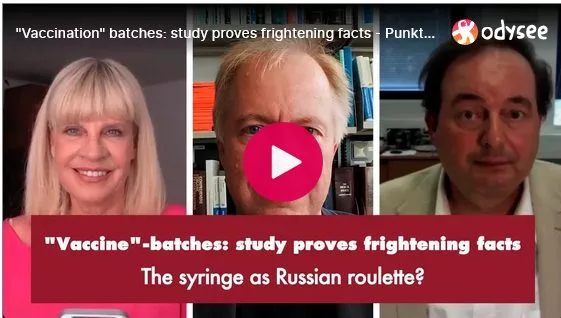
Study: Batch-dependent safety of the BNT162b2 mRNA COVID-19 vaccine
An investigation by five German scientists of the variability of batches of the Pfizer/BionTech BNT162b2 mRNA COVID-19 vaccine, using a recent Danish study as the basis for their study.
“The blue [batches] .. do not even represent 5% [of doses], but they are related or have been reported to be related to almost 50% of the registered deaths.”
English Transcript:
Interview with Prof. Dr. Jörg Matysik & Prof. Dr. Gerald Dyker
Milena Preradovic: Until now, anyone who claimed that the so-called vaccination was not a uniform one, that there were different batches that did different things, was quickly dismissed as a conspiracy theorist. But now there is a Danish study that suggests not only that Biontech supplied different batches, but also that there were big differences in reported side effects and vaccine damage among the different batches. Five professors and scientists from German-speaking universities have been investigating this matter for some time. They also sent their questions to Biontech and the Paul Ehrlich Institute. The answers turned out to be meager. Two of these professors, two chemists, are now with Punkt Preradovic. Hello, Professor Dr. Jörg Matysik and Professor Dr. Gerald Dyker.
Prof. Dr. Jörg Matysik: Good afternoon.
Prof. Dr. Gerald Dyker: Good afternoon.
Milena Preradovic: Let me introduce you briefly. You are both university professors, Professor Matysik, you have a chair in Analytical Chemistry at the University of Leipzig and Professor Dyker, you teach Organic Chemistry at the Ruhr Uni Bochum. Together with three other professor colleagues from German-speaking countries, they have questions for the pharmaceutical manufacturer Biontech and for the Paul Ehrlich Institute, responsible for the quality control of vaccinations. They have written several letters and received few answers. Now you have looked into a new Danish study that reveals something astonishing: that there were different batches of the so-called vaccination from Biontech with different potential for harm was previously dismissed as a conspiracy theory. Now the Danish study has proven it. What exactly does it say?
Prof. Dr. Gerald Dyker: Yes, that is correct, Ms. Preradovic. The Copenhagen scientists evaluated 7 million inoculations of the Biontech vaccine that were administered in Denmark, and they did this by consulting a database from the reporting office where suspected vaccine side effects could be reported. After all, there is something similar in Germany. And for these 7 million vaccinations, there were 70,000 such suspected cases of so-called adverse events. 20% of them are classified as serious by the Copenhageners. And there were also five hundred and seventy deaths. So they have counted how many of these adverse events fall on the individual batches, and they have evaluated that. And what comes out of that, we’re now going to see on a graph. So here we see the graph, and each individual batch has been given a point in this field. On one axis the number of vaccinations of this batch is plotted, on the other axis the number of these cases. And what we see here quite clearly at first glance and already marked for us by the Copenhagen colleagues, we see here three groups on the far left, relatively close together the ones marked in blue. The greens are all near this compensation line in the middle and then down here just pretty flat at the very bottom still the yellows. What this means in concrete terms can be seen in an example. Let’s simply take this green point.
Prof. Dr. Gerald Dyker: This is the batch that has been inoculated most frequently in Denmark, i.e. over 800,000 times. And now we go over here to the other axis and find out well, about 2000 reports have come to the 800,000 for vaccinations. That means one report of a suspected case on 400 vaccinations. That is not little, if one compares that, which one knows otherwise from flu vaccinations. Quite particularly it looks now however here with the blue ones. These have obviously been vaccinated significantly less. None of these blue batches has ever come over 80,000 vaccinations in Denmark anyway. And now we make simply also a simple calculation: 8000 suspicion announcements, on 80,000 inoculations. That means one SAR for every ten vaccinations. And if we take a close look at the figures – we now have the exact figures on which this graph is based – there are also batches where one SAR results in only six vaccinations. That is a huge difference compared to the batches marked in green. Well, and then we have the yellow batches down here, the yellow-marked batches. They’re barely getting out of the background noise. And there are indeed batches where, out of 200,000 vaccinations, not a single suspicious report has been received. That corresponds to what should be the normal case according to Minister Lauterbach. Evil tongues would remark, however, that this is also how placebos would look.
Milena Preradovic: Well, that’s pretty intense. Can we say, before anyone starts complaining, that this study is a serious and proven one?
Prof. Dr. Gerald Dyker: Yes, you can absolutely say that. So we have not really been surprised by the fact that there are different qualities and effects of the individual batches. We already asked Pfizer Biontech in January 2022 what they thought of the “How Bad is my Batch” website. And they told us at that time, “We don’t know, we don’t know anything about it and in general, so no. So everything has the same quality.” Well, and the consumer expects that all batches have the same quality, but obviously they do not. And now what about the seriousness here? At that time, we did not pursue the question any further because we could not be completely sure. Yes, but here it is, after all, a working group at the University of Copenhagen. It has appeared in a peer-reviewed journal. And the publisher, that’s Wiley, after all. That’s also a highly reputable publisher from the science scene. So what they found there, and it’s all from official data that’s available in Denmark. That has to be taken seriously. By the way, the hint to the listeners, everybody can also read this in detail himself. Simply the name “Max Schmeling”, you can easily remember. Is the same name as the famous boxer enter in Google and in addition the keyword Safety. And it is publicly available. You can then find this publication and look at the details there.
Milena Preradovic: So there are dangerous batches and harmless batches and the most dangerous batches, so the blue line that we just saw, they were injected the least. So what explanation can there be for that?
Prof. Dr. Gerald Dyker: Yes, I would like to continue there. In this study, you can also find more detailed information about that. The yellow batches, the completely harmless batches account for 30% of the vaccination volume in Denmark, but the green batches account for over 60%. The blue ones, suspect, not to say really highly dangerous batches, they do not even represent 5%, but they are related or have been reported to be related to almost 50% of the registered deaths.
Milena Preradovic: But that’s intense. Yes, yes. But do you know why they became so few? So I mean, one wonders yes, if that.
Prof. Dr. Gerald Dyker: That’s exactly what we were wondering. Yes, there are actually only three possible explanations. And that is, you have to know that a typical batch, at least in the early days of vaccination, is about 1.4 million doses. We know that because on the homepage of the Paul Ehrlich Institute it says, to celebrate the day, that the first batches have been released and that there were three batches for 4.1 million vaccinations. So a little less than 1.4 million per batch. So, if these batches have this size and in the maximum here the dangerous batches have been vaccinated only 80,000 times in Denmark, we do not know now how it looks in the other countries, then this could indicate that it has been noticed that something is wrong. And then they said, “Well, we’d better stop here. This thing is really dangerous now.” But then it was obvious that the recall was carried out secretly and quietly. I’m not saying that’s what happened. That would be one possibility. There’s a second possibility that maybe smaller batches of an experimental nature somewhere, going in the direction of process optimization, were done and those were thrown on the market. That could explain if they are smaller batches. A third possibility would be, of course, that all this has been spread much further over many countries. But that would then shift the main problem, where did the main amount of vaccine doses go, only to other countries.
Milena Preradovic: So I don’t really like any of these explanations.
Prof. Dr. Gerald Dyker: None of the explanations is really good and I see it as the case that those responsible, whether it is Biontech or those responsible for the release, have a duty to provide an explanation. I could only offer what we thought about it in the discussion among us professors. But we don’t have to explain it, they have to provide it. And of course we have also asked, but we have not received an answer.
Milena Preradovic: I mean, you just said that the study is only about Denmark. Now the question is: “Is this transferable to Germany, for example?” Logically, different batches would have to have been injected here. Otherwise it is rather illogical.
Prof. Dr. Jörg Matysik: Well, we contacted our Danish colleagues and asked them exactly about this. And it is already the case that the dangerous batches have also appeared in other European countries. And by the way, if you look at the sequence of the batch numbers, these blue ones of this dangerous batch have appeared again and again and not at the beginning and just in different countries, so widely spread, temporally and spatially.
Milena Preradovic: Of course, that speaks against explanation one, so along the lines of “We’ve injected something dangerous into people, now we’re withdrawing it.” So that would speak against it. Wouldn’t it?
Prof. Dr. Jörg Matysik: Yes.
Milena Preradovic: Okay. So basically we can almost rule out explanation one. Now, the Paul Ehrlich Institute is responsible for the quality control of these so-called vaccinations. Are they actually only responsible in Germany? Or also further afield?
Prof. Dr. Jörg Matysik: No. When they approve something, the approval applies to the entire European region. So in this respect, the responsibility that rests on the institute is considerable.
Milena Preradovic: So also for Denmark. Now I have to ask, did the PEI not do its job?
Prof. Dr. Gerald Dyker: Yes, we can take a look at that now. With the next graphic. Now was the PEI involved in the release of the Danish batches. So they are responsible, as Jörg Matysik just said, for all of Europe, but they can also say to another institute from other countries, if they have tested something, simply: “Yo, we believe that and we take that, we stamp that!” But the central responsibility already lies for Pfizer Biontech, with the Paul Ehrlich Institute. So let’s look at the next graph. So, here we see the list of batches with their batch numbers as they have been evaluated by the Copenhagen colleagues. And in this list, we have highlighted in blue the batches that were also marked as blue by the Copenhagen colleagues. And we have then compared them ourselves. Was the PEI involved in the release of these, for example, highly dangerous batches and you can find the data in the drug information system, called Amici, and this is provided quite officially in Germany by the Federal Institute for Drugs and Medical Devices. And what we found there is, yes, the PEI has released all the batches that are marked blue and therefore quite dangerous. For the green marked ones, they have released the vast majority. And now really a surprise for us. With the yellow, absolutely harmless batches, the PEI was only involved in the release of a single batch, here the one up there. Yes, and in all the others, where apparently it is not considered necessary that in these batches PEI gives the green light.
Milena Preradovic: But if the Paul Ehrlich Institute has not released the yellow, that is, the more harmless batches now, who has? Is there any way to understand that?
Prof. Dr. Gerald Dyker: We don’t know that. But that is one of the questions that we also sent to, yes, now recently to the Paul Ehrlich Institute. As I said, no answer so far.
Milena Preradovic: Yes, you can of course get the idea, if you are very, very suspicious, that you say okay, they knew that these are harmless batches and then said, “don’t need to release” or?
Prof. Dr. Gerald Dyker: That’s possible, that would support the initial suspicion that maybe it’s actually something like placebos. By the way, maybe an information that is also very interesting for the listeners. We imagine placebos in the case of injections, it is saline solution and sugar pills in the case of any tablets. According to newer EU law and this was confirmed to us by our lawyer for drug rights, placebos may also contain all auxiliary substances. Only the actual active ingredient must be missing. And that would mean in this case that everything is allowed. Nanoparticle formation may certainly be made. Only the modified RNA must be missing.
Milena Preradovic: Well, that’s actually incredible when you hear it like that. Now the question is, how did the Paul Ehrlich Institute test in general? Did they go into production and take samples? That’s how I imagine it.
Prof. Dr. Jörg Matysik: Yes, that’s what you would expect. The Paul Ehrlich Institute itself states on its homepage that they do have the samples sent to them. So that’s hard to believe, but it’s really there. That would be like if food controls in restaurants would take place by pizza taxi. So the health department has things come to them by pizza cab. And everybody knows that can’t be, that can’t be. So of course they have to go into the kitchen and they have to open the refrigerator and see if the milk is fresh and so on. But that does not happen. The Paul Ehrlich Institute also has the obligation to examine the end products. That is the legal obligation. We don’t know if they do that. They have not confirmed that to us. There was only a statement from the Paul Ehrlich Institute itself that certain data would not be submitted. So that is also suspicious. And we can also say that what is done with the samples that are sent is really very, very little and very superficial. And that’s obviously four things: the color is examined only by eye. So that’s really very, very cheap. Against a white and black background, certain light maybe, but you can’t do it that way. There are really methods that are better for that. The PH value is determined. This is an action of a few seconds. The identity and integrity of the RNA are determined and that’s all. And there are actually much better methods that could be used. More modern methods, but they are not used here. So I think from the analytical side, there is a lot of wasted potential, so you just have to do more.
Milena Preradovic: Yes, there seems to be little interest in this. I mean, it’s completely crazy that the PEI doesn’t know whether they are testing the end products at all. Then when they write back, we don’t have any data on that now. That is crazy. So you can summarize, or I would put it this way: The Paul Ehrlich Institute has completely failed.
Prof. Dr. Jörg Matysik: Yes, so we would like to get more positive answers from the Paul Ehrlich Institute so that we could contradict him again. Because I think all of us as citizens of the country and the EU would really expect and wish and also have a right that the authorities work properly. But the silence that we are experiencing, of course, makes us uneasy and we just have to keep at it. It can’t stay like this, it has to be cleared up and it will be cleared up.
Prof. Dr. Gerald Dyker: At this point I would like to suggest that we take a look at how Professor Karl Lauterbach and the PEI assess the situation themselves. And for that, again, I’ll call up a graphic. Here we have a recent entry from Karl Lauterbach’s Twitter channel, on June 6. A photo from the lab at the Paul Ehrlich Institute. Here on the right is Professor Cikutek, the director of the Paul Ehrlich Institute. And how does Karl Lauterbach comment on the visit? “Today I visited the Paul Ehrlich Institute. Professor Klaus Cikotek and I are in the room where efficacy of the Biontech vaccine is being tested. Without the PEI, vaccines would have been approved much later. Nevertheless, there was no compromise on safety. Thank you, PEI.” Now what’s interesting is, we have a poster here of what was put up by PEI there in their lab. And in the higher resolution, you can also clearly decipher what’s on there. The title is “Batch release – A success story”. Now, what we also noticed here and that will give rise to further questions, that is, as I just read out, Lauterbach said, that the efficacy is checked here. And yes, on this slide, PEI also claims that they are reviewing the efficacy. Then I have to say, some things are unclear to us, because we are not yet aware that there would be somehow a rapid test for efficacy of the vaccines. Normally, after all, that is tested in a clinical trial. Maybe they still have a possibility somewhere that they already test in the test tube whether the messenger RNA is transcribed and any spike proteins are formed. But is that really efficacy testing? We don’t have any information yet how they are going to do that and we will certainly ask about it in another letter.
Milena Preradovic: Very good. Now I think we can cancel the Lauterbach again from our conversation. We know there are different batches that can do different things. We know that the Paul Ehrlich Institute does not test very carefully. And now, of course, you ask yourself: How do these different batches come about in the first place? You said at the beginning that a vaccine should always have the same composition. How can that be? Can this happen by chance or must it be intentional?
Prof. Dr. Jörg Matysik: Well, if you normally get medical devices and they are certified according to GMP, i.e. Good Manufacturing Practice, and this is defined very precisely how it has to be done, then there is no freedom. Here in this case, however, it is noticeable that the tolerances are extraordinarily large. We are aware of the tolerances. Once a document has been leaked and then the chief batch examiner before the Federal Administrative Court also made some statements about it, which confirmed exactly what was to be read on this leaked document. And these tolerances are just way too big. So the particle size may vary between 40 and 180 nanometers. And that’s extraordinarily much in volume then. And these particles have properties that are size-dependent. This means that the different sizes that are permitted can lead to very different effects. Even the PH value is allowed to fluctuate by a whole unit, so the degree of acidity, so to speak. That is too much. We also do biological samples in a laboratory and we know that only one tenth of a unit is allowed to vary. Otherwise, things have different samples. And these nanoparticles are much, much more sensitive in terms of their architecture. So from that point of view, these large tolerances make no sense at all to us and we cannot understand why such ranges are allowed.
Prof. Dr. Gerald Dyker: Well, there could be one reason. And that is that we chemists and also our physicist colleagues, who also work in such areas, are aware that it is incredibly difficult to achieve nanoparticles with a narrow size distribution. As Jörg Matysik just said, that is very, very sensitive to many things, stirring speed, addition, velocity, temperature, concentration, and so on. And if they also have different locations where they produce it, it shouldn’t surprise you if they deviate quite often from the ideal size for some batch. And perhaps because they didn’t want every second or third batch to be dumped, they were so generous with the tolerance range for particle size. However, there are one or two additives, such as ALC 315, which is a very important additive. According to the statutes, according to the tolerances, double the concentration may be added. And there is somehow a contradiction to what Jörg Matysik just said, as everything else in the drug production area is immensely strictly regulated.
Prof. Dr. Jörg Matysik: And let’s remember at the beginning of the vaccination campaign, it was said that you must not even shake the containers. So that’s how sensitive it was. So just a little bit of shaking and then it already disintegrates. And then on the other hand, we have these enormous tolerances. So we can’t bring that together. So at least we have questions to the manufacturer and unfortunately nothing has come so far.
Milena Preradovic: Yes, these tolerances worry even the layman. You just mentioned ALC 315, this substance. Can it be dangerous, this substance for example?
Prof. Dr. Gerald Dyker: Yes, I would like to say a few sentences about that. ALC 315 is, so to speak, a supporting substance, a supporting concomitant substance, in the literal sense. This compound is classified as a so-called cationic lipid. It is not a naturally occurring substance, it has been tailor-made and because it can interact very well with the MRNA, it ensures that it is packed in. At the same time, this substance forms the nanoparticles in the first place, and this substance has the property of being able to transport the modified RNA through cell walls to the site where the genetic information is then translated and the spike proteins can start producing it. So, if you look now and we have done what is written on the safety data sheets of American companies that supply ALC 315, then it clearly said “May cause cancer”, “could be carcinogenic”. It also said that it is a skin irritant. It must not get into the eyes under any circumstances. So for us chemists, if we were to buy this substance, it clearly means that our employees in the laboratory must be instructed in the safety regulations for handling it. And we had then asked the company, “what about this? “May cause cancer?”
Prof. Dr. Gerald Dyker: And then they wrote us back: “No, that was a mistake.” And that was pretty much on February 14, 2022, then that entry disappeared. Then that was gone. Nevertheless, it still remains. It could cause irritation, skin irritation. And now I’m saying to myself from my chemical expertise, “Well, if it can cause irritation on the skin, why shouldn’t it cause something subcutaneously?” And as far as the potential cancer risk, yes, so the substance is able to interact with genetic information, namely RNA. Of course, it would also interact with DNA. And it already enters the cell from the entire mechanism. Yes, what is there to prevent it from interacting somehow with DNA, to prevent it from reaching the cell nucleus? I don’t know, I can’t say. But the EMA was obviously of the opinion: “Nope, this should be harmless and as a total package it will be allowed through”. And we didn’t find anywhere that real tests for carcinogenicity had been done on such a potential with it.
Milena Preradovic: Then they just took away the reference to possible cancer that this can cause. So that’s very, very adventurous. But that’s not the only thing. We have already talked a lot about these so-called vaccinations. What you also noticed is the unusual color. You’ve mentioned this before, I think in letters to Biontech. What is that all about?
Prof. Dr. Jörg Matysik: Well, the color was actually the first thing that made us realize that something was wrong. Because the package insert said that it must not show any color. It would have to be colorless, and as soon as color appeared, the vaccine would have to be discarded. But we know that particles that are this size show color phenomena due to scattering. And that is the physics of scattering. We know that from the blue color of the sky for small particles and that exactly the light here before. That means, depending on how you hold the vessel and the angle between the lamp, the vessel and the eye, color phenomena should appear. If they don’t appear, it would mean that the material is out of order, because the particles are agglomerated, that is, they are stuck together, then they are too big and then there is a certain grayish color like the rain clouds in the sky.
Milena Preradovic: And that’s what happens.
Prof. Dr. Jörg Matysik: And that then leads to the doctors getting exactly the wrong information. So the vaccine that is still intact, that is small particles, that should show this color appearance, but exactly that should be discarded, because that which is agglomerated, that is spoiled, that should then be vaccinated. So this information is exactly the other way around. Of course, we noticed this and therefore immediately contacted Biontech. So actually we want to kindly offer our help and explain this to them. So the physics of scattering, biochemists and biologists don’t need to know that, but we would have liked to explain it. But they simply weren’t interested in understanding that either. So we regret that very much. We would have liked to talk to them at the beginning. Yes, but that was refused.
Milena Preradovic: You two and your three scientific colleagues have written several letters to Biontech and the Paul Ehrlich Institute. We have just heard, so nothing really came out of it. Were there any reactions at all?
Prof. Dr. Jörg Matysik: We received a response from Biontech at the very beginning. That was because our letter was published in the Berliner Zeitung, which is why the company also had to respond in the Berliner Zeitung. The answer that was there was extremely unsatisfactory and shows us that they did not understand our question at all. They had said that some ingredients would indeed show color. But if we look at the list of ingredients, there are no substances that have a color of their own. That’s why they didn’t understand that the appearance of color is not due to the molecular properties, but to the complex, to the whole, because it scatters the light. So, unfortunately, you don’t understand that.
Milena Preradovic: Yes, either you don’t understand it, or it’s smoke candles that you’re throwing. What were the reactions of the Paul Ehrlich Institute? They did answer at some point.
Prof. Dr. Jörg Matysik: Yes. We also wrote a number of letters, but received very few answers. Some of them were simply grotesquely wrong. We were given a reference to the Pharmacopoeia as an answer. Chapter softening point of suppositories. So what is completely off the mark. And then at the end they sent us a notice, so an official decision told us that we will not receive any more information. That’s an authority and I think that’s where we’re entitled too. So it is especially true for me, I have been vaccinated twice and I would like to know exactly what was injected into me. And that’s why we are in court now. The date of the proceedings has not yet been set, but we will now get to know each other before the administrative court.
Milena Preradovic: Yes, I wish you good luck in any case. You just mentioned that the Berliner Zeitung supported you, printed your letters, I think mostly behind a paywall, so not visible to everyone. But what was the reaction of the other media to your research and questions?
Prof. Dr. Gerald Dyker: Ms. Preradovic, the Berliner Zeitung has to defend itself. So our series of articles is freely accessible.
Milena Preradovic: I take everything back.
Prof. Dr. Gerald Dyker: By all means from other media on the topic we are talking about here today, there have been two interviews in the last six weeks, once with the radio, but also film recordings of a well-known daily newspaper. Both interviews have been edited in.
Milena Preradovic: Okay, so you could say it was interested editors who said this has to go public and then there was someone above them who said, “Better not.” Professor Matysik, you just mentioned it yourself, you had this injection twice. How do you feel about it today?
Prof. Dr. Jörg Matysik: Well, I didn’t have any complaints after the first injection, the second time some joints hurt. I might have been able to get a grip on that with vitamins and antioxidants, and I hope that things will be okay. But the long-term effects are of course unknown. But I would think less of me now, but rather of the many young people who have many more years ahead of them and can therefore suffer many more long-term manifestations. That’s why I’m afraid that there’s still a lot to come.
Milena Preradovic: But what were your thoughts when you read the safety sheets and saw what you had let yourself in for?
Prof. Dr. Jörg Matysik: Yes, I remember the moment very clearly when I received the safety data sheet for ALC 315. It was on my screen as a PDF and I couldn’t believe it. It ran ice-cold down my spine, because it’s clear that such substances and that’s a job to read safety data sheets and to understand that you use something like that without warning and actually almost without need. That is completely incomprehensible to me. I would have liked to know that beforehand and that it was concealed from me, which I found very unpleasant.
Milena Preradovic: Yes, I think so. After all these letters, after all their research, after all these non-answers. What is your bottom line now? Your conclusion? Let’s start with you, Professor Dyker.
Prof. Dr. Gerald Dyker: Yes. My bottom line as things stand now, there have been at least four disasters in the Corona years. First of all, the disaster that came out of a lab and that now seems to be pretty much assured that it came out of the lab, the virus was released and it is related to Game of Function research. A highly dangerous piece of research. And here I would also like to express my gratitude to the physics professor Wiesendanger from Hamburg, who has been coming forward with this again and again for well over a year, demanding that a stop be put to this. We are lucky that the virus that was released is not much more dangerous than it has just turned out to be. The second disaster is the Corona measures, which have damaged the cognitive and psychological development of many young people. Yes, we in particular, who are also active in teaching, are already noticing that some things are becoming more and more difficult to teach, even if the Abitur grades are getting better and better. There is already a certain discrepancy. Yes, then the third catastrophe: Here in Germany, but also in other countries, we have clearly introduced a kind of social credit system, certainly to the applause of very many in the population.
Prof. Dr. Gerald Dyker: And that is the social credit system: if you didn’t want to participate in this quite experimental vaccination, then you were socially out and you were ostracized and had a lot of disadvantages. Yes, what was thrown overboard at the same time were the cultural achievements that we have ethical medical rules. Nobody should be forced to participate in any experiments. Yes, and the fourth catastrophe, that is now these damages, of many long-term damages we do not yet know how they will develop. Many of the victims will be affected for a long time, perhaps for their entire lives, and this must be dealt with, even if it can be very unpleasant for many in politics and the media, and can be quite revealing. And the matter is not over now. It is by no means over. In one of your last broadcasts, it was also said that WHO should be given appropriate powers. And what I personally also find very bad and irresponsible: There is talk that this ModRNA technology, because it is cheaper and can be adapted more quickly, is now to be used for practically all forms of vaccination. I think that’s very, very terrible. I’m not anti-vaccination, I’ve been vaccinated for various things, but with the ModRNA technology, no way.
Milena Preradovic: If you consider that it was not approved for years or decades and suddenly it is to be injected for all people in this world, that is very negligent. Professor Matysik, your conclusion?
Prof. Dr. Jörg Matysik: Well, I am disturbed that we had to see how quickly our society turned over, that is, how quickly the media pulled the academies together and all other opinions were silenced. There was something eerie about that, and I had hoped that I wouldn’t have to experience something like that. I mean, we are and want to be a democracy. We have a wonderful Basic Law, and we have to live up to it. And it’s simply not acceptable that so many people are silenced. People have to talk to each other. We live from the diversity of opinions. Diversity is good” is trumpeted everywhere, but then especially when it comes to opinions. That’s what it’s all about. There is no intellectual process even without the diversity of opinions. Life is also not interesting at all. So what is taking place here in terms of one-sidedness, that is not only to my taste, but I think that it should not remain so. The second thing I noticed is the overturning of opinions. I think now, I will take just one example, that is the Greens. When I was a doctoral student, genetic engineering, biotechnology, the possibility of genetically producing insulin came up. In the past, this was extracted as a by-product of slaughter, and I still remember that I had really difficult discussions with people from the Green Party, who said: “So everything with genetic engineering, that must not start at all. It must remain taboo to even go in that direction. And of course, insulin is a good thing, but it would be breaking a taboo, and that must not be allowed. So that’s why not even insulin is allowed to be genetically engineered.” And today the same people are of the opinion that genetic engineering products must be injected under the skin of other people by force. It is completely incomprehensible to me what has happened in these brains. So there I am at a loss. And that is of course unsatisfactory when you perceive processes in your environment among your fellow human beings that are not accessible to you at all and that are completely inexplicable. You can’t really talk about it with these people.
Milena Preradovic: It is difficult. One thing is clear: we live in a historical time, that is quite clear. That makes it exciting again, to put it in a positive way. And what I also noticed, so a lot of what we discussed today would actually even be a case for the prosecutors. So, my dear Professors Dyker and Matysik, thank you very much for this interview and especially for your work. And I will keep my fingers crossed for you. And don’t give up. Thank you very much for being here.
Prof. Dr. Jörg Matysik: Thank you very much.
Prof. Dr. Gerald Dyker: Thank you for the invitation.
Milena Preradovic: Well folks, the weapon “All conspiracy theories!”, is slowly losing its power. However, clarification remains difficult and is actively prevented. YouTube has just deleted the channel of the medical association MWGFD and therefore this video is not running on YouTube. We are also already counted there and of course that means loss of reach. So if you think this video should definitely get out there, please share it diligently. I wish you a good time. See you soon.
Links:
Original video: “Vaccination” batches: study proves frightening facts
A full transcript of the interview: Vaccination batches: Study proves the frightening – with Prof. Dr. Gerald Dyker and Prof. Dr. Jorg Matysik
The original Danish study: Batch-dependent safety of the BNT162b2 mRNA COVID-19 vaccine
Berliner Zeitung article: Chemists Ask BioNTech: Are There Vaccine Lot Differences?
Update 1 – 8th July 2023 – Dr John Campbell casts a critical eye over the data
Italian Medicines Agency bans Astrazeneca coronavirus vaccine batch ABV2856





